Top Toys to Keep Your Lonely Cat Engaged
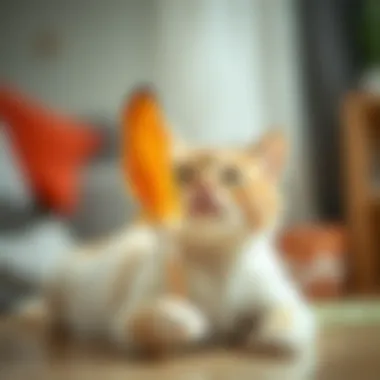
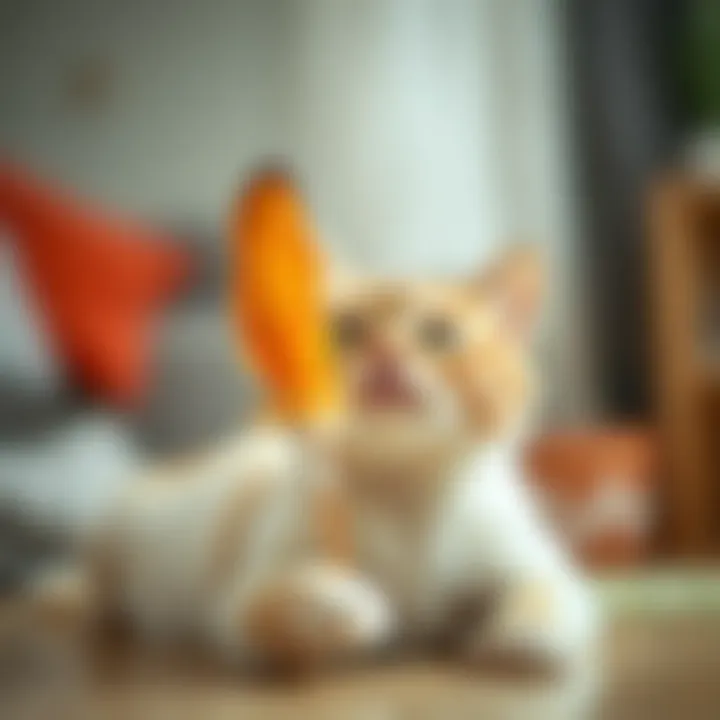
Intro
Cats, those clever little creatures, can often be solitary souls. While they may enjoy the company of their humans, they also require their own space to thrive. For those furry friends that find themselves alone more often than not, stimulating toys can be an absolute game changer. Engaging toys not only keep a cat occupied but also support their mental and physical health.
As we explore the best toys tailored for these solitary felines, it's important to consider the benefits that come with interactive play. A toy designed to captivate a cat’s attention can turn a dull afternoon into an adventure. The focus here is on understanding how a solitary cat interacts with toys, and the insights gained can shape the way we choose to entertain and support them.
This guide provides a thorough overview of engaging toys meant for cats that may not always have a companion to romp around with. We will discuss different categories of toys, their benefits, and practical tips that can enhance the life of a solitary feline.
With these insights, cat owners can make informed decisions, ensuring their pets are kept both mentally stimulated and emotionally content.
Understanding the Needs of Lonely Cats
Cats, despite their reputation for being solitary creatures, have emotional and social needs that can often go unmet in environments where interaction is limited. Understanding these needs is crucial for pet owners hoping to create a fulfilling and stimulating environment for their furry friends. The solitude that many cats experience can lead to behavioral issues, anxiety, and even physical health problems. Providing the right toys and engagement activities is essential in addressing these concerns.
The Emotional and Behavioral Impact of Loneliness
Loneliness in cats can manifest in various ways, affecting their emotional state and behavior. When a cat lacks interaction, it can lead to increased stress levels, resulting in undesirable behaviors such as aggression, destructive scratching, or excessive vocalization. Cats are naturally inquisitive; when they feel isolated, they might resort to lethargy or show signs of depression.
Moreover, studies suggest that prolonged loneliness can hinder their overall well-being, potentially leading to health issues. By acknowledging emotional needs, cat owners can take proactive steps towards their pet's mental wellness.
Signs of Boredom and Loneliness in Cats
Many cat owners may be unaware of the signs of boredom or loneliness that can silently indicate a cat’s discontent. Common indicators can include:
- Excessive Sleeping: While cats enjoy their naps, a shift to lethargy might mean their environment lacks stimulation.
- Attention-Seeking Behavior: Cats may scratch furniture or meow persistently to signal their loneliness.
- Aggression or Irritability: Frequent mood swings might manifest as aggression, especially when they are not engaged physically or mentally.
- Over-Grooming: This often indicates anxiety stemming from boredom or lack of engagement, leading to excessive self-cleaning.
Recognizing these signs early is key to preventing deeper emotional distress.
How Toys Can Alleviate Loneliness
Toys serve not just as entertainment but as tools to enhance a cat's quality of life. Engaging toys can redirect negative behaviors, stimulate their minds, and provide a sense of companionship—even in their owner’s absence. The right type of toys can:
- Encourage Physical Activity: Interactive toys can promote movement, helping cats release pent-up energy and reducing the likelihood of obesity.
- Stimulate Mental Challenges: Toys that require problem-solving can engage a cat’s intellect, fulfilling their needs for stimulation and curiosity.
- Provide Emotional Comfort: Some toys are designed to mimic prey, offering cats an outlet for their hunting instincts, which can alleviate stress and feelings of isolation.
By selecting toys tailored to a cat’s personality and needs, owners can significantly enhance their pet's emotional and mental well-being.
"A fulfilled cat is a happy cat; discovering the right toys is the first step in preventing loneliness."
A thoughtful selection of toys paired with engagement techniques creates an enriching environment, crafting a harmonious balance that caters to a cat's natural instincts and needs.
Categories of Cat Toys
Understanding the different categories of cat toys is crucial when addressing the needs of lonely cats. Each category serves a specific purpose, targeting distinct aspects of a cat's behavior and emotional well-being. By recognizing these categories, pet owners can make informed choices that cater to their feline friends, ensuring that their toys not only entertain but also enhance their quality of life. This section covers various types of cat toys and highlights their respective benefits, helping pet owners navigate the available options more effectively.
Interactive Toys for Active Play
Interactive toys stand out as essential tools for keeping cats physically engaged. These types of toys require participation from the cat, which encourages them to expend energy and stay active. For instance, laser pointers and feather wands are popular choices that tap into a cat’s natural hunting instinct. The movement of the toy mimics the traits of prey, triggering excitement and curiosity.
- Benefits:


- Helps to maintain physical fitness, reducing the risk of obesity.
- Engages the cat’s mind, fostering problem-solving skills as they figure out how to catch the toy.
- Strengthens the bond between cat and owner during playtime, allowing for interactive experiences that create trust and affection.
Solo Play Toys for Independent Exploration
Cats often appreciate toys that allow them to play independently, especially if they are home alone for extended periods. Solo play toys encompass a range of options, from balls to plush toys, which can entertain a cat without requiring human involvement. Something as simple as a ping-pong ball could capture a cat's attention for hours.
- Benefits:
- Encourages self-play, helping cats feel less lonely when left by themselves.
- Provides opportunities for physical activity, cutting down the chances of boredom-related behavioral issues.
- Allows exploration and experimentation, contributing to a cat's sense of autonomy.
Puzzle and Treat Toys for Mental Stimulation
Puzzle and treat toys are designed to challenge a cat's intellect. These toys often involve mechanisms that reward the cat with treats once it solves a puzzle or performs a specific action. Brands like PetSafe offer a range of solutions that can keep your cat engaged for considerable periods.
- Benefits:
- Stimulate a cat’s brain, which is crucial for its overall mental health.
- Can decrease feelings of boredom by providing objectives for the cat to achieve.
- Encourages healthy eating habits by promoting slow feeding and rewarding playing with treats.
Catnip Infused Toys for Sensory Engagement
Catnip toys take advantage of the catnip plant, which can evoke playful and euphoric behavior in many felines. These toys combine play with sensory delight, as cats often go wild for the scent of catnip. Toys filled with catnip, such as sock mice or stuffed figures, can ignite playful antics, making them a hit among cats who respond well to this herb.
- Benefits:
- Enhances the joy of playtime, promoting physical activity through engaging behavior.
- Offers sensory engagement that can alleviate stress and anxiety in lonely cats.
- Provides variety to the cat's playtime, keeping the experience fresh.
Wand Toys for Bonding and Activity
Wand toys serve a dual purpose by encouraging both physical activity and bonding between cat and owner. These toys consist of a long stick with a string or ribbon attached to it, often featuring feathers or other enticing elements that draw a cat's attention. The owner manipulates the wand to create movement, inviting the cat to jump and chase.
- Benefits:
- Fosters interaction, allowing owners to bond with their cats during play.
- Helps to improve a cat's agility and hunting instincts through active play.
- Offers an engaging way to exercise together, reinforcing the human-animal connection while providing mental stimulation for the feline.
Top Picks for Cat Toys
When it comes to keeping lonely cats happy, a selection of top-notch toys can make a world of difference. This section dives into toys that not only grab a cat's attention but also promote mental stimulation, physical activity, and emotional well-being. Selecting the right toys is crucial, considering that different cats have unique preferences and temperaments.
The following picks are not just popular; they've been rated favorably by pet owners and cater specifically to the needs of solitary felines. Each toy is aimed at enhancing a cat’s quality of life, enabling them to engage in play and exploration, even when they are by themselves.
Best Interactive Toys
Benefits
The primary benefit of interactive toys is their ability to reduce boredom significantly. Cats are natural hunters, and these toys mimic the chase, tapping into their instinctual drives. Not only do they provide physical exercise, but they also foster cognitive skills as cats figure out how to engage with the toy. Many owners find that these toys help their cats spend energy, which can lead to better overall behavior at home.
User Reviews
User feedback on interactive toys often highlights their effectiveness in keeping cats entertained. Owners rave about their cats' improved mood and behavior since introducing these toys. However, some note that a few cats may lose interest over time. It’s important to rotate the toys or show them new techniques to keep things fresh. Users often recommend setting a timer or schedule for playtime to maximize the toy's engagement.
Highly Rated Solo Play Toys
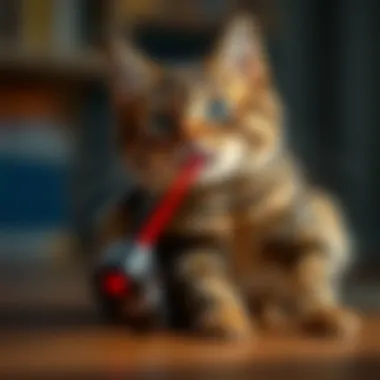

Benefits
Solo play toys are specifically catered to independent exploration. These toys allow cats to entertain themselves while you’re busy with daily tasks. Their ability to engage cats without human interaction is a significant advantage, particularly for owners who might be at work or away for several hours. Many owners appreciate how these toys can occupy their cats while also mitigating behavioral issues that arise from boredom.
User Reviews
Reviews often cite the longevity and durability of solo play toys as standout features. Many pet parents find that these toys withstand the vigorous play often displayed by cats. However, some owners mention the necessity of ensuring the toys are suited to their cat’s size and chewing behaviors to avoid any choking hazards.
Most Effective Puzzle Toys
Benefits
Puzzle toys not only entertain but also improve cognitive function. Studies indicate that keeping your pet intellectually stimulated contributes to longer-term happiness and health. Engaging them in problem-solving tasks helps prevent destructive behavior that often arises out of boredom.
User Reviews
User reviews tend to highlight how these toys effectively tire out energetic cats. However, some owners note that not all cats get the knack of them; thus, starting with simpler puzzles and gradually increasing complexity is recommended. Positive feedback often mentions the satisfaction and sense of accomplishment cats display when they successfully retrieve treats.
Popular Catnip Toys
Benefits
The primary draw of catnip toys is their ability to induce a playful high in cats. When cats play, they are more likely to exercise and engage with their environment, which is critical for their physical and mental health. Moreover, the behavior triggered by catnip can lead to increased affection and bonding time with their owners.
User Reviews
Pet owners commonly report a noticeable uptick in playfulness when catnip toys are introduced. They appreciate how these toys can also help in redirecting inappropriate behavior by providing an exciting outlet for energy. However, it’s essential to monitor how frequently your cat engages with catnip, as too much can lead to desensitization, reducing the toy's effectiveness over time.
In summary, selecting the right toys is key to keeping lonely cats fulfilled and content. Each type of toy—from interactive playthings to solo and puzzle options—offers benefits uniquely suited to addressing the needs of solitary cats. By understanding the variety and purpose behind these toys, cat owners can enhance their pets’ environments significantly.
Considerations Before Selection
Choosing the right toys for your feline friend is not just a trivial task; it demands careful consideration. Understanding your cat’s needs and preferences can dramatically enhance their play experience, which plays a key role in combating loneliness. In this section, we’ll dive into why you should assess your cat’s preferences, evaluate the safety of materials used in toys, and why budgeting for quality should be a priority.
Assessing Your Cat's Preferences
Every cat is unique, much like fingerprints. Some may take to chasing a feathered wand, while others may prefer pouncing on a laser light. Observing how your cat interacts with different toys can provide you insights into their preferences. Here are some ways to assess those preferences:
- Experimentation: Introduce various types of toys into their environment. Note which ones hold their attention the longest.
- Interactive vs. Solo Toys: Consider whether your cat tends to enjoy toys that engage them with others or prefers solitary play. A social butterfly might get bored with things meant for solo exploration.
- Materials: Some cats are naturally drawn to soft, plush toys, while others prefer the crunch of crinkly materials. The texture can significantly impact their interest.
Assessing these preferences can prevent wasteful spending and ensure that the toys you select enrich their solitary playtime.
Safety Factors and Material Considerations
Safety is paramount when selecting any pet toy. Cats often have a tendency to chew, scratch, or ingest parts of toys. Here’s what to keep in mind:
- Non-toxic Materials: Always opt for toys crafted from non-toxic materials. Read labels and product details of brands like PetFusion or KONG that are known for their high safety standards.
- Durability: Look for toys that can withstand vigorous play. Investing in sturdy options can prevent potential choking hazards that arise with broken toys.
- Size Matters: Ensure the size of the toy is appropriate. A larger item might be safer and prevent accidental swallowing.
- Regular Inspection: Make it a habit to routinely check your cat's toys for any signs of wear and tear. A toy that was once safe could become a hazard over time.
Keeping these safety factors in the forefront can help you establish a secure play environment for your cat.
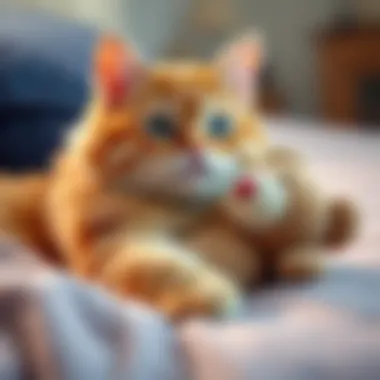
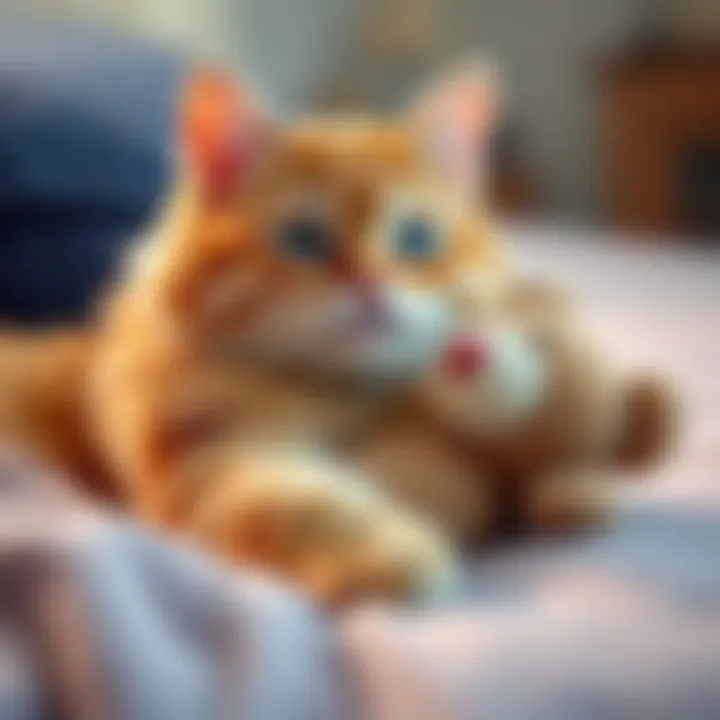
Budgeting for Quality Toys
Quality doesn't always come cheap, yet it’s essential to look at toys as investments in your cat’s well-being. Allocating an adequate budget can yield long-term benefits. Here’s how you can approach budgeting for your cat’s toys:
- Research Before Purchase: Sometimes, the least expensive option could lead to accrued costs over time due to replacements. Take into account brands that offer quality assurance.
- Consider Play Value: Some higher-priced toys provide engaging play that lasts longer and encourages your cat to be active. Weigh how much you’d pay for prolonged joy vs the fleeting entertainment of cheaper alternatives.
- Quality Over Quantity: Rather than stockpiling numerous inexpensive toys, focus on buying fewer, higher quality items that will entertain your cat better.
- Look for Deals: Keep an eye on sales from retailers. Websites like Chewy or Amazon often have discounts on pet toys, especially during seasonal sales.
> In summary, taking the time to assess your cat’s preferences, ensuring their safety, and budgeting for quality can greatly enhance their overall play experience and help combat loneliness effectively.
Engagement Techniques for Lonely Cats
Cats, those seemingly indifferent creatures, can be surprisingly emotionally complex. A lonely cat often faces a unique struggle, leading to issues such as anxiety and boredom. Engaging techniques are vital to ensure these felines thrive and find joy even in solitude. By actively incorporating various engagement methods, you can mitigate the adverse effects of loneliness on your furry companions.
Rotating Toys for Continuous Engagement
Just like a kid’s toy collection, cats can easily become tired of the same ol’ playthings day in and day out. Rotating toys is a brilliant way to keep your cat’s curiosity piqued. By introducing different toys every few days, it's as if you are presenting a new adventure each time they see these items.
- Why Rotate Toys? It helps in preventing overstimulation from the same toy. It also lets them rediscover toys they might have overlooked in their initial excitement.
- How to Do It: Create an accessible storage area for toys. Keep some hidden away, and regularly swap them out. This is much like bringing out seasonal clothes; it keeps things fresh and interesting.
- Benefits: Stimulates your cat mentally and physically, reducing the chance of unwanted behaviors resulting from boredom.
"A change is as good as a rest." Using variety in your cat’s playtime supports mental health, much like how you might feel energized after a change of scenery.
Incorporating Playtime into Daily Routine
It's essential to intertwine playtime into both your and your cat's daily routine. Just as you schedule work meetings, try making time for consistent play with your furry friend. Here’s how to go about it:
- Set Specific Times: Morning or evening sessions can become a ritual—like brushing your teeth or having your morning coffee. Cats often feel encouraged when they know what to expect.
- Duration Matters: Even short bursts of play, say 10 to 15 minutes, provide great mental stimulation. Use toys like laser pointers or feather wands to engage your feline enthusiastically.
- Involve Family Members: Make it a family affair. Everyone can take turns engaging with the cat, which also fosters bonds within your household.
When you integrate this structured play into your life, not only do you cultivate closer ties with your cat, but you also contribute to its overall happiness.
Utilizing Toys for Training and Obedience
Some might think that toys are just for fun, but they can also serve as effective tools in training your furry friend. Utilizing engaging toys can teach obedience and tricks, enhancing your cat’s mental acuity. Here's what to consider:
- Positive Reinforcement: Pair toys with rewards. Using items like treat-dispensing puzzles can motivate your cat to learn. They associate good behaviors with pleasure, making training smoother.
- Interactive Engagement: Toys that require your cat to think critically help in honing their problem-solving skills. Puzzle toys, for example, prompt cats to find treats hidden within, giving them a sense of accomplishment.
- Bonding Opportunities: Training sessions foster the connection between you and your cat, urging loyalty and trust.
Incorporating toys not only nurtures your cat's intelligence but can also create a bond that blossoms into a deep relationship built on understanding and mutual enjoyment.
Culmination and Further Insights
As we wrap up our exploration into cat toys tailored for solitary feline companions, it is vital to underscore the significance of choosing the right toys. Cats, being naturally curious creatures, often find themselves in need of engaging activities to stimulate their minds and bodies. The right toys can serve not just as outlets for energy, but as lifelines that connect them to a world of interaction and fun, even when they’re left to their own devices. In essence, well-selected toys can alleviate boredom and reduce stress, enhancing the emotional and physical health of your pet.
Recap of the Benefits of the Right Toys
When thinking about the benefits of appropriate toys for lonely cats, several key advantages stand out:
- Mental Stimulation: Toys that challenge their problem-solving skills or mimic hunting behavior can keep a cat’s intellect engaged. This is crucial for preventing behavioral issues that often arise from boredom.
- Physical Activity: Toys that encourage movement help maintain physical health. Regular play can reduce the likelihood of obesity and related health problems.
- Emotional Well-Being: Engaging toys can help ease anxiety caused by loneliness. A cat that is entertained cannot dwell on feelings of isolation as intensely.
- Encouragement of Natural Behaviors: Certain toys, like those mimicking prey, enable cats to express natural instincts in a safe environment, fulfilling their inherent needs.
Consider this: providing a variety of toys can cater to different play styles. Some cats may prefer batting at small balls, while others enjoy chasing laser pointers or pouncing on feathered toys. Understanding these preferences can enhance the effectiveness of their playtime, ultimately leading to a happier and healthier pet.
Resources for Ongoing Learning
To continue enhancing your knowledge and understanding of how to care for lonely cats, several resources stand out:
- American Veterinary Medical Association: Offers detailed articles on pet behavior and health, including tips for managing loneliness.
- Cat Behavior Associates: A fantastic site that focuses on feline behavior, offering insights on how loneliness affects cats and how to mitigate it.
- Reddit - r/cats: An active community of cat lovers where you can share experiences, ask questions, and learn from fellow pet owners.
- Books on Cat Psychology: Titles like "Think Like a Cat" by Pam Johnson-Bennett provide in-depth insights into feline behavior and needs.
- Local Shelters and Animal Welfare Groups: Many have seminars or workshops focusing on pet care and can provide personalized advice based on your cat's unique personality.
"Toys are not just playthings; they're bridges to companionship and joy that every lonely cat deserves."
By continuously seeking knowledge and adapting your approach, you are paving the way for a more fulfilling relationship with your feline companion.















